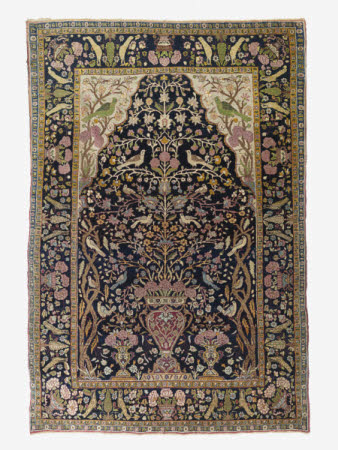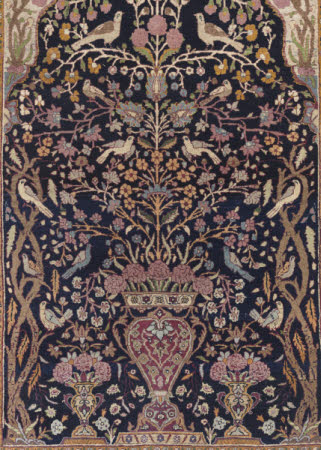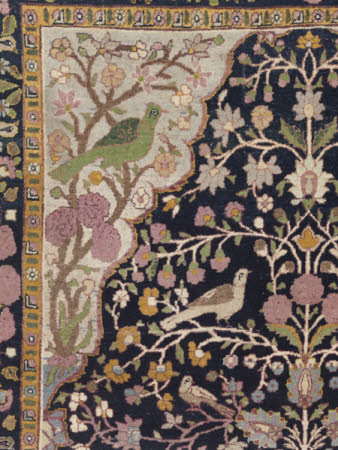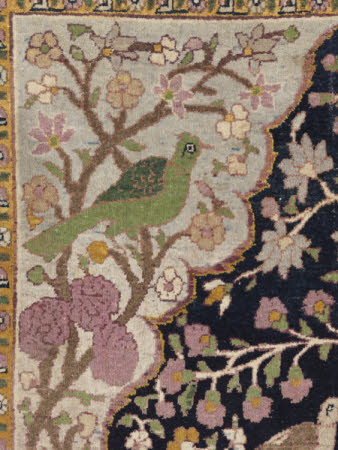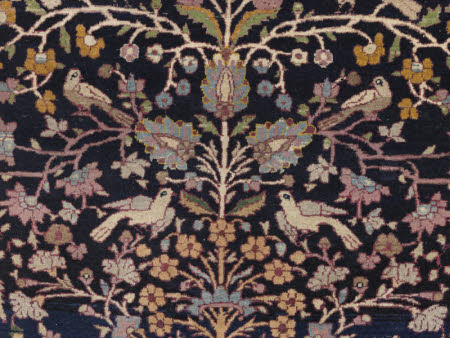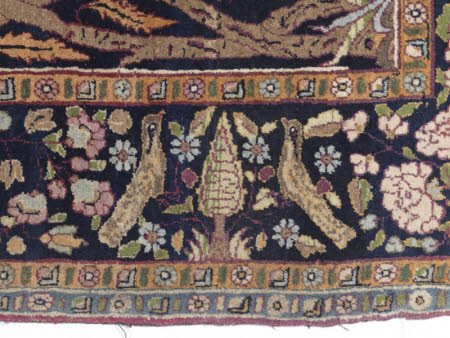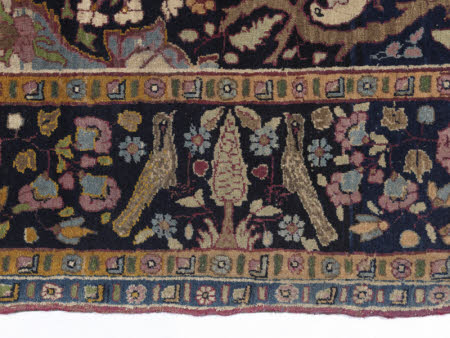Carpet
Category
Carpets, rugs and mats
Date
1900 - 1933
Materials
Wool pile, cotton with some rexine applied to the edges
Measurements
2075 mm (W)1380 mm (D)
Place of origin
Isfahan
Order this imageCollection
Nuffield Place, Oxfordshire
NT 1651044
Caption
Carpets are one of the most familiar and important of the Islamic arts. The vibrant imagery in this carpet – flowers springing up from vases, birds perching on blossoming branches – is symbolic of the Gardens of Paradise and creates a rich but balanced effect. Persian carpets from the 19th-century onwards were mostly created for Western middle and upper classes to decorate homes. This early 20th-century carpet design draws from a range of Persian carpet styles, including floral carpets, prayer rugs and nomadic community designs.
Summary
A Persian carpet with an asymmetric knot weave, incorporating patterns of brightly coloured blossoming vines, perching birds, flowers emerging from vases, and an architectural arch at the top of the carpet. The carpet is referred to as a ‘prayer rug’, but it was made for decorative purposes. An early 20th-century style carpet thought to have been woven in Isfahan, Iran. The carpet also has similar stylistic connections to Kerman (Kirman), Iran. The carpet is in good condition and contains an asymmetric knot and depressed weave with signs of restoration at the warp ends and corners. Rexine has been applied to the carpet edge to help weigh it down. The knot count is approximately 120 knots per 2cm square.
Full description
The carpet contains a bright composition of flowers springing up from vases with resting birds sheltering in the central field. A slender tree with meandering branches climbs through the central field, with pink, blue and yellow flowers blossoming into the intervening spaces. The brown and cream hued birds could represent turtle doves or nightingales. The imagery symbolises the Gardens of Paradise and creates a rich but balanced effect. Gardens played an important role in daily life in Persia. Whether the verdant carpet florals refer to the earthly or heavenly gardens of Paradise, gardens symbolise the promise of well-being and tranquillity. Persia, officially known as Iran from 1935, was a crossroads for global migratory populations. Persia was conquered by regimes with various religions and was shaped by wide-ranging artistic influences. When Persia was part of the Mongol Empire in the 13th-century, connections to China were absorbed into the Perso-Islamic artistic language. Animals such as dragons and tigers were incorporated into carpet designs, while the architectural forms of Persia were also a continuous presence. Natural elements such as birds and peonies frequently emerged in carpet decoration. Within this carpet, Chinese peonies blossom within the central indigo field on top of the flowering tree. Alternating flowers sit next to stylised tulips with a simple chevron shape within the slim yellow borders of the carpet. Pink and blue fan-shaped carnations also emerge from pink branches in the central field. Tulips and carnations were a favourite flower of the Ottoman Empire and were often incorporated into court carpet designs. Damask roses spring up from vases throughout the pattern. The Rosa Ispahan was discovered in the city of Isfahan, Iran, where roses were a popular feature of city gardens. This style of carpet is referred to as a ‘prayer rug’. Muslim prayer does not use objects to speak to God, but books, buildings, and decorative items are connected to worship. Prayer rugs have a pointed arch at the top, which symbolises a mihrab, or a prayer niche found inside a mosque. The presence of a mihrab in the carpet design confers the Islamic influence on Persian design, but the inclusion of birds firmly places this carpet in the decorative sphere. The arts of Central and West Asia did depict animate creatures in response to global influences throughout history, but the art connected to Muslim practice could not depict living beings. Artists communicated religious significance through calligraphy, geometric forms, and vegetal decoration. Early 20th-century carpet designs drew from a range of earlier Persian carpet styles, including floral carpets, prayer rugs, and nomadic community designs combined through progressive artistic adaptation. Carpet weavers responded to the heightened market demand, and carpet designs creatively evolved into a complex mixture of symbolism and scenes of visual serenity to correspond to perceptions of Western taste. This carpet has been attributed to Isfahan, but also has features linking it to Kerman (Kirman) as a potential place of production. Christo Kefalas April 2020
Provenance
The carpet was acquired before 1933 by William Morris and Elizabeth Anstey, later known as Lord and Lady Nuffield, to decorate their previous home in Westover Hall. The carpet was likely acquired from a commercial store or dealer in England. Now in the Nuffield Place collection of William R. Morris, 1st Viscount Nuffield, by bequest to Nuffield College, University of Oxford in1963 and then transferred to the National Trust in 2011.
